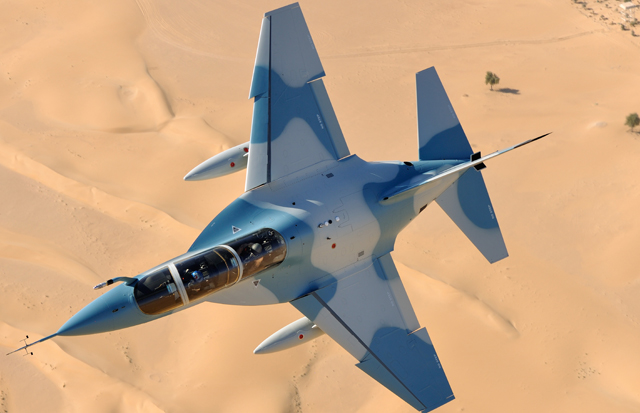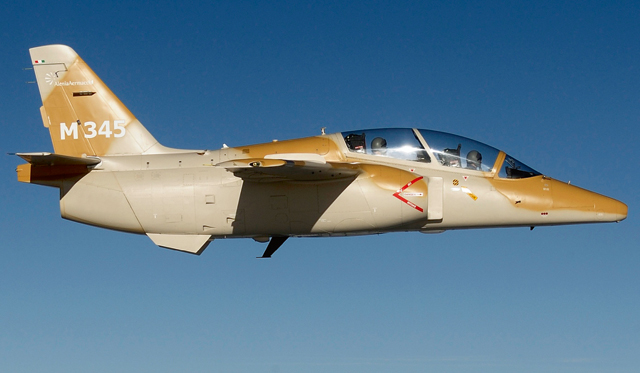Tucked away in a hangar just off Alenia Aermacchi’s trainer assembly line at Venegono Superiore in the north of Italy is an aircraft that is part of the company’s more-than-100-year history, but which will also form a key part of its future.
The aircraft in question is an M-311, currently painted in the distinctive livery of Italy’s Frecce Tricolori aerobatic display team. The M-311 is ultimately derived from the S-211 – a turbofan-powered trainer originally produced by SIAI Marchetti, then Aermacchi, and now, following the consolidation of Italy’s aerospace industry, Alenia Aermacchi, which is part of the Finmeccanica group. In many ways, it is the recent history of the nation’s aeronautical sector in microcosm.
Regardless of which, Alenia hopes to leverage that history and give a new lease of life to the platform as the M-345 HET (High Efficiency Trainer). Broadly speaking, it takes the same basic airframe as the M-311 but adds new avionics and Williams International FJ44 engines to replace the original Pratt & Whitney Canada JT15Ds.
Alenia forecasts a market of some 250 units for the M-345, with Italy likely to be first in the queue. Although there is no order in place yet, Rome has expressed a tentative commitment for up to 30 examples, with a number destined for the Frecce Tricolori to replace the team’s aged MB-339 jets.
The M-311 lurking in the Venegono hangar is the demonstrator aircraft that will effectively serve as the initial flight-test and certification prototype. The new Williams powerplants will be installed over the coming months. Some “very limited redesign activity” will be required, as air intakes and nacelles will need minor adjustment, says the airframer.

In all, 56 orders for the M-346 have been taken from Israel, Italy, Poland and Singapore
Alenia Aermacchi
First flight of the reconfigured aircraft is anticipated for the final quarter of 2015 and new-build prototypes would then arrive from the end of 2016, ahead of likely service entry with the Italian air force in 2017.
The M-345 will fit in a niche, the company thinks, between basic screener aircraft and bigger lead-in fighter trainers such as its own M-346. That segment is largely occupied by high-speed turboprops such as the Pilatus PC-21, which gained popularity in part on cost grounds. But, says an Alenia executive, potential customers may be having a change of heart.
“We think this aircraft is mature and is on the market at the right time. Many air forces that were in love with high-performance turboprops are starting to realise that no matter if it is pushed to the limit, it will never reach the performance of a real jet,” he says.
In addition, he suggests that the financial argument no longer adds up – the increased complexity of systems and engines means that a modern turboprop’s operating cost is much closer to that of the M-345. Plus, some of the training activity previously limited to the larger – and more costly – jet trainers can be shifted to the smaller, single-engined aircraft, generating further savings.
To give an example of the potential for cost-cutting, Alenia suggests that the M-345 is around one-third cheaper to operate per hour than its bigger brother.
Overall, the M-345 fits neatly into Alenia’s philosophy for trainer aircraft, which is to provide what it describes as a “total training system”. Of course it is not alone in this outlook, but it says it is “best placed” to provide to a customer everything “from the very beginning to operational conversion”.
At the bottom of the range is the SF-260, a turboprop-powered screener and basic trainer brought in as part of the incorporation of SIAI Marchetti. However, customers for the 1960s-era type have dwindled, with Alenia’s backlog comprising a final six examples for an undisclosed African nation.
Faced with this situation and the challenge posed by new-generation types such as the Grob Aircraft G120TP and Airbus Defence & Space PZL-130 Orlik, Alenia is now thinking about a clean-sheet replacement for the dated design. Although it says it is only at the “brainstorming” stage for the programme, it intends to work with the Italian air force to define the requirement.
“We are starting to think about an aircraft that will be more or less in the same class,” says an Alenia executive. The new aircraft would have a similarly sized engine and maximum take-off weight to the SF-260, but it would feature a carbonfibre fuselage. The company says it hopes development activity can begin in the next two to three years.
But for all the plans further down the weight range, Alenia’s most important product remains the M-346. It has yet to sell in vast numbers, having so far garnered a total of 56 orders from four nations, but the customers it has attracted are generally regarded as some of the world’s more demanding air forces.

The M-345 builds on Alenia's long history of trainer production, adding a new Williams engine and avionics to the existing M-311
Alenia Aermacchi
Singapore has taken delivery of all 12 of its aircraft, which are currently based at Cazaux air base in the south of France, and both Italy and Israel have begun receiving some of their orders for six and 30 M-346s, respectively. Additionally, fabrication of long lead-time items for Poland’s eight aircraft has begun ahead of handover of the first example, scheduled for 2016.
Some 600 sales of the Honeywell F124-powered type are targeted over a 30-year period. Alenia still hopes that the United Arab Emirates will eventually come on board as a buyer, firming up a tentative agreement for 48 jets dating from 2009. “They have not dropped the discussion; it is just frozen,” says an Alenia executive. France, too, may also be interested in the type, driven by an increasingly pressing need to replace its fleet of aged Dassault Alpha Jets. A delegation from the French air force and the nation’s DGA procurement body travelled to Italy in late September to evaluate the M-346, and, as an Alenia executive points out, French pilots can see the type operating on almost a daily basis at Cazaux.
However, the biggest potential sale would be to the US Air Force to replace its Northrop T-38 Talons. The nascent T-X programme envisions a requirement for around 350 jets, and Alenia has announced an intention to partner with General Dynamics for the bid. The T-X programme is snarled in budget wrangles, however, and although Alenia remains hopeful, it does not see a firm time frame for the contest.
Nonetheless, it says it believes that with the increasing complexity of combat types, there will be a growing need for trainers that can accurately mimic the performance of the aircraft and their systems.
“This is the challenge the M-346 addresses. It is an aircraft that gets closer to the performance of a frontline fighter and the same level of sophistication, or at least being able to simulate and train the pilot well before he begins the conversion on to whatever,” says a company executive.
Completing Alenia’s offering is a suite of ground-based training systems, including full flight simulators and other classroom aids. Alenia points out that up to eight aircraft and two simulators can be linked simultaneously to the network to allow tactical scenarios to be played out, with other students able watch in real time on computer screens.
“That way you can really exploit all their training time,” says Alenia. Additionally, tutors are able to replay and review the action in real time, allowing a scenario to be repeated without the need to return to base first, cutting wasted time.
That all adds up, Alenia says, pointing out that Israel expects it will be able to cut six months from its training syllabus for each pilot when it has fully switched to the M-346 and its associated systems.
Back in the relative quiet of the assembly line, five aircraft are in various stages of production. The plant is turning out two aircraft every month but could easily increase this to four – or even eight if more workstations are added.
Efficiency tweaks, most recently automated wing drilling, are constantly being brought to the line to improve its performance. The capacity for growth is clearly there.
Now all Alenia needs to do is bring in some more of those elusive orders.
Source: Flight International



















